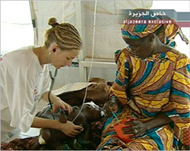Aid reaching Niger, but slowly
International aid, slow to arrive despite repeated pleas from the United Nations, is finally getting to drought-stricken Niger.

But it has yet to reach outlying villages such as Dan Mallam, some 650km east of the capital, where the hungry can do little but await help and the next harvest.
“Everything that the stomach can contain, we eat … anything that can calm the hunger, Ibrahim Koini said on Sunday. The 45-year-old looks much older than his 45 years with his gray beard and emaciated frame.
“We’ve come to eat the same leaves we give our cows.”
The diet of acacia and other leaves is already taking its toll on children, whose malnourished state is clear in their distended bellies and heads that appear too big for their fragile, skeletal bodies.
Acacia leaves provide some, but inadequate nutrition because they lack iron, zinc, magnesium or protein. Adults can get by on the calories such a diet provides, but calories alone are not enough for children, according to Unicef.
Schooling affected
Children stay home from school because they are too weak to concentrate on their studies.
 |
|
Adults are left watching their |
Thirteen-year-old Yacoumba Mati, described by his teacher as a bright student, has managed to keep going to class and take his final exams, saying he wants to go on to become a doctor.
But he said he hopes to leave Niger one day, “because here there is nothing to eat”.
Most villagers have already sold their cows and goats.
Milk and flour, let alone meat, are too expensive.
Niger’s government offers millet at $18 for a bag of 100kg, but that is as out of reach for most villagers as the unsubsidised price of $54.
Even a lifesaving trip to an international aid group’s feeding centre and clinic just 46km away in Maradi is unaffordable.
Adults are left watching their children’s energy, muscles and weight dwindle away.
Mouhamou Fakirou cannot count on his skinny, shaky legs, so the frail 2-year-old boy leans against his father for support.
“I cannot afford to leave the rest of the family behind to take the little one to hospital,” said Mouhamou’s father, Ibrahim Fakirou, fanning away the flies dancing around his son’s face.
“I have to plow my farm to feed the children and my wife is seven months pregnant. I just cannot leave.”
Poorest nations
Niger regularly ranks among the world’s poorest nations.
 |
|
Most villagers cannot afford to |
But it was drought and a locust invasion last year that brought Fakirou and some 3.6 million others in this nation of 11.3 million to this state.
The UN first appealed for help in November and got almost no response.
Another appeal for $16 million in March got about $1 million.
The latest appeal on 25 May for $30 million has received about $10 million.
Donations jumped dramatically in the last week because of increased media attention and TV images of starving children, UN humanitarian chief Jan Egeland said on Friday.
When the first UN appeal was made, only $1 per day per person would have helped solve the food crisis, the UN has said. The cost has risen because it is more expensive to treat malnutrition than to prevent it.